CEDAR ISLAND — The early morning sky was in a moment of indecision, split in half, unsure of its intentions. To the north, a blue sky was growing the promise of a sunny day, however, to the south, dark clouds still held the outlook of soaking rain showers.
I was trailering a boat down to this isolated community on the far eastern tip of Carteret County. From there, I would head out into Pamlico Sound in search of a tiny island best known as a location to fish for red drum. As I pulled into the empty boat ramp area, a woman was playing with two black Labrador retrievers on the nearby beach. One of the labs was much older, its muzzle the color of frost.
Supporter Spotlight
After launching the boat, I motored through the protected harbor with its high walls of riprap rocks. Gliding across the emerald waters and into the open sound, the light winds delivered a welcomed message of calm waters. Pointing the boat north, I headed off in search of Raccoon Island, the last hunk of land where the Neuse River spills into the vast sound. I knew that the island was about seven miles away from the boat ramp, but after four miles, an island was not coming into view. So, as any prudent mariner, I pulled out my cell phone and opened up the maps app. After a slight unintended detour into West Bay, I was soon following the pulsating blue dot towards Raccoon Island, but I was not heading there to fish.
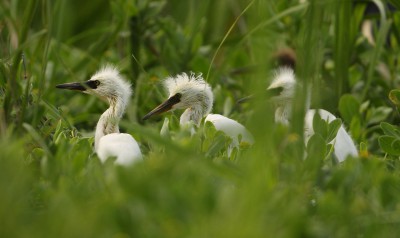
Over the years, I have been asked many times, “Why don’t you ever see baby egrets, pelicans or gulls on the beach or in the salt marsh?” Well, it’s mainly two reasons. First, many different species of shorebirds prefer to nest in remote isolated locations such as small islands in marshes, sounds and rivers that are intentionally selected away from human activity. Secondly, new chicks are usually already the same size of an adult and have similar plumage when they fledge from the nest. Thus, after the chicks have left the nesting islands, the casual observer will not recognize them as cute “baby chicks” running about.
Coastal birds like to nest in large numbers, in groups called colonies, so they can all benefit from a collective effort. With more alert sentries to call out the danger alarm as well as plentiful fighters to drive out an intruder, the survival rate of eggs and chicks increases. Selection of a colony site is also influenced by the availability of food and thus the birds all end up at the same spot, similar to fishermen when they hear where the fish are biting. Birds in the colony also learn to follow other, more successful hunters to their favorite spot, again, just like fishermen. Colonies with terns, plovers and skimmers tend to sprout up on the sandy spits at the ends of barrier islands while pelicans, herons and egrets favor isolated island with grasses, shrubs and trees. In North Carolina, 25 different species of water birds nest colonially and rely on such sites.
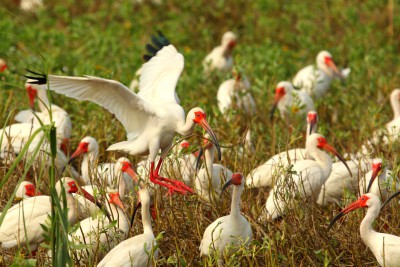
As I approached the island, I was a bit concerned; it was low and flat without any significant shrub thickets or trees. No wonder I couldn’t find the island, it is not prominent enough to rise above the horizon. I was expecting an “island” but this was basically a big hunk of salt marsh made up of various tall grasses. My hopes of seeing any nesting ibis, herons or egrets sank just like this island appeared to be doing. Closer to the island, I began to see birds flying around the south shore. Laughing gulls, lots and lots of laughing gulls, were flying in and then dropping into the grasses. Their trademark riotous call could be heard from quite a distance. I soon began to see heads poking up through the grasses like periscopes. Looking deeper into the low grass, I saw clusters of glossy and white ibis, tricolored herons and snowy egrets. The plentiful laughing gulls had created a perimeter, nesting closer to the shore. My mood lifted as my doubts faded away like the distant curtain of rain draping from a cloud over the Pamlico.
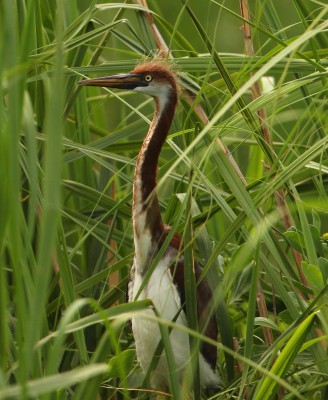
With so many birds sitting on nests, I could now see why this island had been listed as an important nesting site for the glossy ibis, tricolored heron and laughing gull. It appeared that many of the birds were still sitting on eggs, but it was hard to tell since the nests were not visible through the grasses. Then, every now and then, I could get a glimpse of a fuzzy-headed chick. The snowy egret chicks appeared to be top heavy as their heads would wobble while the tricolored heron chicks stood erect and stable. One chick was shy as it poked out its stubby variegated bill, a glossy ibis chick.
Supporter Spotlight
Even with the crowded conditions, everything was pretty peaceful until a bird would land too close to another nest, creating an uproar of squawking and wing slapping. One laughing gull was popped so hard you could hear it out on the boat. White ibis and laughing gull chicks were nowhere to be seen. Either they hadn’t hatched out or they were tucked well into the vegetation.
The adults were resplendent in their magnificent breeding colors and plumage, coming and going, in search of and returning with food for the chicks. The fleshy face of the white ibis is fire engine red, glossy ibis feathers shine with a bronze glow, while elegant plumes drape off of the tricolor heron and snowy egret.
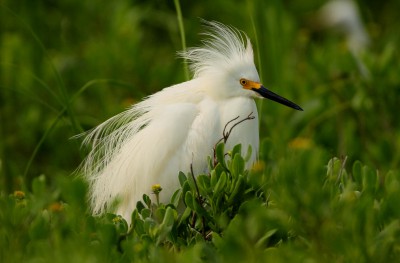
Throughout the last half of the 1800s, these elegant breeding feathers were at times more valuable than gold. To satisfy a new craze in fashion, millions of colonial nesting birds were slaughtered to “harvest” the chic breeding plumes used mainly to adorn women’s hats. Snowy egrets in particular were targeted and were brought to the verge of extinction. At the time, killing these birds simply for their feathers was unregulated and because of their tempting value, many hunters turned to plume hunting. All along the Atlantic coast, breeding sites were wiped out, the adults killed, eggs left to rot and chicks left to starve.
Disgust with the annihilation of these birds ignited the formation of the Audubon Society chapters in many states, which influenced the creation of bird-protection laws and the establishment of bird refuges. To enforce these laws, the Audubon Society hired the nation’s first game wardens. One such warden was a man named Guy Bradley.
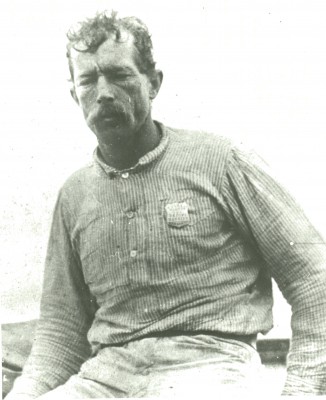
In 1902, Bradley was hired as Audubon’s first game warden charged to protect a huge swath of the Florida’s west coast down to Key West. Even though it was now illegal in Florida, the carnage continued. A reformed plume hunter himself, Bradley went about his job with a vigilance that created many enemies and a foreboding prophesy of his death. Three years later, Guy Bradley was shot and killed as he attempted to arrest a familiar plume hunter and his sons on one of the rookeries.
Guy Bradley once described plume hunting as “a cruel and hard calling.” Watching the birds of Raccoon Island, I wondered if he was just doing the job he was paid to do or if he objected to the absurdity of killing birds to satisfy human vanities. A pioneer in wildlife protection, awards are now given in his name to distinguish those that have demonstrated a commitment to wildlife protection through enforcement or conservation. His story is depicted in a movie, “Wind Across the Everglades,” released in 1958.
In 1918, Congress passed the Migratory Bird Treaty Act to protect migratory birds such as the egrets and herons from eventual extinction. Some states were not pleased and challenged the constitutionality of the act, resulting in the U.S. Supreme Court upholding the law in 1920. The act has now been protecting birds for almost 100 years and is being reviewed by the U.S. Fish and Wildlife Service to bolster protection for birds from new hazards that were not around a century ago. Sadly, elsewhere in the world including Eurasia, market hunting continues to threaten birds to satisfy the culinary fad of eating fried songbirds. Yellow-breasted bunting populations have dropped 95 percent during the past three and a half decades due to illegal poaching and a strong black market appetite in China.
Hesitantly, I piloted the boat away from the island and was greeted by a pod of dolphins as I neared the boat ramp. Tucked in among the adults, a tiny newborn leaped completely out of the water, putting a smile on my face. Normally this would have taken my full attention, but today I was still captivated by the sights and sounds of the bird colony. I reflected on Guy Bradley and the courage he had, even in the face of danger, to protect these birds. Birds may not mean much to most people, but to me they are a strong fiber that weaves through the fabric of nature that is worth saving. They are the most obvious of nature’s ambassadors that have the best opportunity to keep us connected to the natural world.
Oh, by the way, I didn’t see any raccoons on Raccoon Island.








